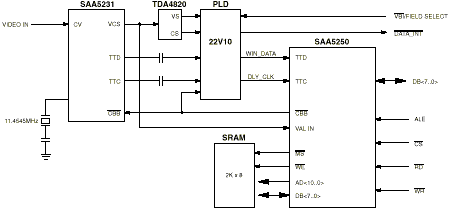Packet 31 - Independent Data Line
This packet is used to implement independent data services. Recently,
the potential for using teletext as a means for distributing data nationally and at speed.
All the other packets relate to a particular page, and thus cannot carry data which is not
associated with a specific page. Packet 31 is defined to be page independent and can be
transmitted at anytime without affecting the correct operation of the basic teletext
service.
Packet 31 consists of
Up to 15 different data channels
Optional Data format
Repeat Facility
Continuity Indicator
Data Length Indicator
Service Packet Address
Allows individual users or groups to be identified
User Data
Between 28 and 36 data Bytes
Cyclic Redundancy Check word
This is the system used by DBI to transmit vast amounts of data via
there licence on ITV
A Packet 31 line is different is structure from the ordinary teletext line. It also
differs from ordinary teletext in that the information in a IDS line can be interpreted
without reference to other lines. The ordinary teletext structure is page based. The
structure of a IDS line is shown in the diagram below. The initial section of the line is
similar to the ordinary teletext line. The subsequent structure is different from that of
the ordinary teletext line.
| Bytes in Packet 31 - Independent Data Service Line |
2 |
1 |
1 |
1 |
1 |
upto
6 |
upto
6 |
1 |
1 |
28
to 36 |
2 |
CRI |
Framing Code |
Data Channel |
Design
Code |
Format
Code |
IAL |
Service
Packet Address |
Repeat
Indicator |
Continuity
Indicator |
User Data |
CRC |
|
|
|
|
|
|
|
|
|
|
|
The Packet 31 line structure is different from the ordinary teletext line structure in
that it is not page dependent. This means that only changing data needs to be sent to the
receiving decoder. The background image could be generated by a computer program resident
in the receiving decoder. This improves the overall security of the system.
The clock run in and framing code are identical to ordinary teletext line parameters. This
is to enable the use of standard teletext circuitry in the IDS decoders. The fourth and
fifth byte, used for magazine and row address in ordinary teletext (MRAG), are used for
data channel group identification and independent line identification. The fifth byte
identifies the line as an independent line by carrying the data 1111. The data bits are
Hamming system coded to form the byte.
Data Channel ( Byte 4 )
The fourth byte carries the data channel information. Again only four of the bits are data
bits, the rest are Hamming System coding bits. This code specifies which of the 16
available channels the following data for.
Designation Code ( Byte 5 )
Set to 1111, this tells the decoder that the following data is an Independent Data Service
Packet.
Format Type ( Byte 6 )
Specifies format of data following.
Interpretation and Address Length ( Byte 7 )

| 